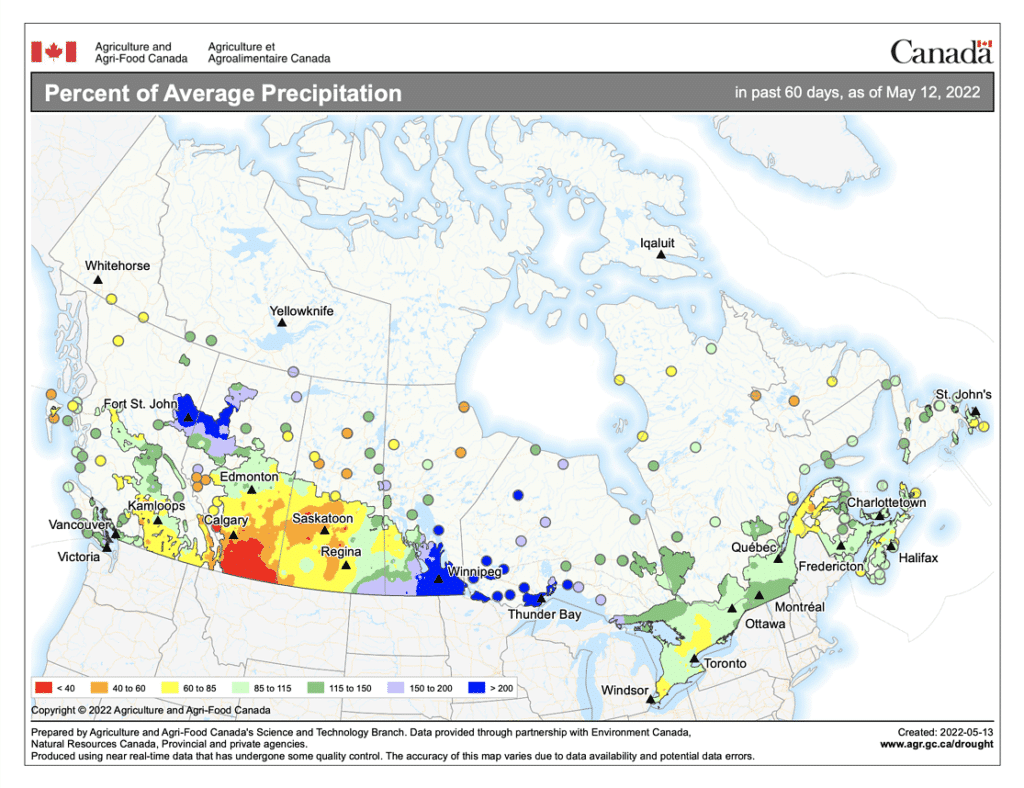The Four Ways Plant Nutrition Helps Deal with Early Season Moisture Stress
Across Western Canada moisture conditions vary significantly with some growers challenged with the lack of moisture, while others are dealing with too much moisture.
Whether you’re experiencing too much or too little precipitation this year, moisture stress is one of the most damaging factors limiting a crop from reaching its genetic potential. Although there is no replacement for water, proper plant nutrition can help maximize water use efficiency and play a critical role in limiting yield loss.

Understanding How Water Interacts with the Plant:
If we start with the basics, moisture stress occurs when the supply of water to the roots is less than transpiration rate from the leaves. There are a two key points from this statement that we can elaborate on:
#1. Water Uptake by the Roots: The key requirement to take up water, and also nutrients, is to develop a healthy active root system and root rhizosphere. Knowing that water stress may be a factor affecting the production this year means more than ever, we need to go on the offensive and target early season root establishment. Some of the key nutrients to drive early season rooting include, Zinc, Phosphorus, Copper, Manganese, Boron, and Calcium.
#2. Transpiration: Transpiration is simply the loss of water through the stomata of the leaves of the plant. The plant losses water to both cool itself, but also to have the release oxygen and intake of CO2 to continue photosynthesis. The rate of water loss is impacted by a number of variables, including (but not limited to) heat, relative humidity, wind, temperature, sunlight, leaf type, and water supply. The goal is to maximize the photosynthetic process in the plant while minimizing water loss through the leaves. All nutrients (outside of Ca, B and Mo) are directly involved in the photosynthetic process, but two key nutrients to manage the plant during water stress are potassium and manganese.
Four Ways Plant Nutrition Deals with Moisture Stress:
- Build the Roots to Access Available Moisture: Build a robust root system with the proper essential nutrients applied onto the seed (PreCede) and/or as a starter fertilizer to be sure the seedling can take up the nutrients immediately to both drive rooting and also photosynthesis. Grow deeper, stronger roots by adding a foliar such as ReLeaf to your herbicide.
- Build Roots to Access Non-Mobile Nutrients: One of the other challenges with low soil moisture levels, is that mobile nutrients such as nitrogen, sulphur, boron, calcium, and magnesium are no longer mobile and can be stranded in the soil profile. It is critical that we develop a healthy root system to access these nutrients.
- Use a Biostimulant: Be sure to include a biostimulant called Cellburst in these applications. Our genetic expression research has shown that the biostimulants used in our formulations trigger the plant at the genetic level to deal with moisture stress. They aid the plant is continuing to respire and conduct photosynthesis and also reduce the production of stress hormones such as Ethylene that can harm a plant and significantly impact plant productivity.
- Get the crop ready for herbicide application: When the crop is stressed the impact of a herbicide treatment on the crop is greater than when the crop is grown under more ideal conditions. Improving the health of the crop with the addition of ReLeaf to your herbicide application will help with “herbicide hangover.”
Address the Stress – Add ReLeaf to your herbicide
Applied at herbicide timing, ReLeaf is a complete NPK formulation to meet the early season nutritional demands of the crop. ReLeaf:
- Provides essential nutrients – Contains the proper nutrients in the right ratio to grow deeper, stronger roots to access moisture and nutrients from the soil.
- Consists of a novel biostimulant – Cellburst Technology to maximize the efficacy of the formulation and address abiotic stress.